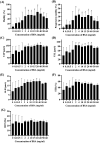High-concentration bovine serum albumin enhances fertilization ability of cold-stored rat sperm
- PMID: 38432992
- PMCID: PMC11017099
- DOI: 10.1262/jrd.2023-085
High-concentration bovine serum albumin enhances fertilization ability of cold-stored rat sperm
Abstract
Cold transport of the cauda epididymides is a useful technique for shipping laboratory rat sperm. Cold transport of rat sperm avoids potential risks of microbiological infection, animal escape or death, and animal welfare issues. Previously, we reported that a cold-storage solution containing dimethyl sulfoxide and quercetin maintained the fertility of cold-stored rat sperm. However, cold-stored rat sperm exhibited a decreased fertilization rate after 24-h storage. To recover the fertility of cold-stored sperm, we focused on the effects of bovine serum albumin (BSA), a cholesterol acceptor that induces sperm capacitation. We sought to determine the optimal concentration of BSA in fertilization medium based on the fertility of cold-stored rat sperm. High concentrations of BSA (40 mg/ml) enhanced the fertilization rate of cold-stored rat sperm and maintained sperm fertility for 144 h. Embryos derived from cold-stored and BSA-treated sperm normally developed into pups after embryo transfer. In summary, high BSA concentrations enhanced the fertility of cold-stored rat sperm and prolonged the storage period to 144 h, thereby expanding the transportable region for genetically engineered rats.
Keywords: Bovine serum albumin; Cold storage; In vitro fertilization; Rat; Sperm.
Conflict of interest statement
The authors declare no competing financial interests. This study was supported by a research grant from Kyudo Co., Ltd. The author, N. M., was employed by Kyudo Co., Ltd.
Figures




Similar articles
-
Quercetin-treated rat sperm enables refrigerated transport with motility and fertility for five days.Sci Rep. 2021 Nov 22;11(1):22641. doi: 10.1038/s41598-021-02166-6. Sci Rep. 2021. PMID: 34811440 Free PMC article.
-
Fertility of cold-stored mouse sperm is recovered by promoting acrosome reaction and hyperactivation after cholesterol efflux by methyl-beta-cyclodextrin.Biol Reprod. 2017 Feb 1;96(2):446-455. doi: 10.1095/biolreprod.116.142901. Biol Reprod. 2017. PMID: 28203712
-
Investigations of motility and fertilization potential in thawed cryopreserved mouse sperm from cold-stored epididymides.Cryobiology. 2014 Feb;68(1):12-7. doi: 10.1016/j.cryobiol.2013.10.007. Epub 2013 Nov 4. Cryobiology. 2014. PMID: 24201107 Free PMC article.
-
Optimized protocols for sperm cryopreservation and in vitro fertilization in the rat.Lab Anim (NY). 2022 Oct;51(10):256-274. doi: 10.1038/s41684-022-01053-5. Epub 2022 Oct 10. Lab Anim (NY). 2022. PMID: 36216983 Review.
-
Stimulation of sperm fertility in vitro by exogenous molecules.Reproduccion. 1981 Jul-Sep;5(3):169-76. Reproduccion. 1981. PMID: 7026315 Review. No abstract available.
Cited by
-
In vivo fertilization improved the cryotolerance and developmental ability of vitrified-warmed rat fertilized oocytes.Sci Rep. 2024 Oct 15;14(1):24198. doi: 10.1038/s41598-024-76073-x. Sci Rep. 2024. PMID: 39406819 Free PMC article.
References
-
- Takeo T, Fukumoto K, Kondo T, Haruguchi Y, Takeshita Y, Nakamuta Y, Tsuchiyama S, Yoshimoto H, Shimizu N, Li MW, Kinchen K, Vallelunga J, Lloyd KC, Nakagata N. Investigations of motility and fertilization potential in thawed cryopreserved mouse sperm from cold-stored epididymides. Cryobiology 2014; 68: 12–17. - PMC - PubMed
-
- Harrison C. Mice on the move. Lab Anim (NY) 2021; 50: 233–235. - PubMed
-
- Takeo T, Tsutsumi A, Omaru T, Fukumoto K, Haruguchi Y, Kondo T, Nakamuta Y, Takeshita Y, Matsunaga H, Tsuchiyama S, Sakoh K, Nakao S, Yoshimoto H, Shimizu N, Nakagata N. Establishment of a transport system for mouse epididymal sperm at refrigerated temperatures. Cryobiology 2012; 65: 163–168. - PubMed

